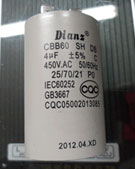Update - related model affected
The issue discussed below has also affected a related model of oxygen concentrator, the Invacare Platinum, and a recall for product correction was undertaken for that model in May 2015.
The affected Invacare Platinum units are from models IRC9LXO2AWQ, IRC5LX02AW and IRC5LXAW with serial numbers in the range from 10CSZ43XXXX to 12GSZ62XXXX (manufactured between March 2010 and August 2012).
9 February 2015
Recall for product correction - fire risk from faulty component
Consumers and health professionals are advised that Invacare Australia, in consultation with the TGA, is undertaking a recall for product correction for certain Invacare PerfectO2 concentrators.

An Invacare PerfectO2 concentrator
It has been identified that there is a potentially faulty component in some units, the compressor motor start-run capacitor, which could rupture and ignite a fire.
Invacare PerfectO2 concentrators are used to supply oxygen-enriched air to patients with lung disease and any fire risk is heightened in such an environment.
Invacare Australia advises that there have been two reports in Europe of units catching fire due to this issue, with no injuries reported. There have been no reports of this issue occurring in Australia.
The affected units are from models IRC5PO2VAW and IRC5PO2AW with batch numbers in the range from 10CSZ43XXXX to 12GSZ62XXXX (manufactured between March 2010 and August 2012).
Information for consumers
Invacare Australia has written to distributors requesting that they contact all affected users and arrange for replacement of the potentially faulty component.
If you or someone you care for uses an Invacare PerfectO2 concentrator check the model and batch numbers to see if it is affected.
If you have an affected concentrator do not use it if there is an alternative available.
If you think you or someone you care for has an affected concentrator and you have not been contacted, contact the dealer who supplied your unit. If you have any difficulties contacting the dealer, call Invacare Australia on 1800 460 460 (8am-5pm Monday-Friday).
Information for health professionals and health facilities

The faulty component is
a Dianz brand capacitor
with date code from
2010.03 to 2012.08
Invacare Australia has written to distributors requesting that they contact all affected users and arrange for replacement of the faulty part.
If you are responsible for an Invacare PerfectO2 concentrator you should check the model and batch numbers against those listed above. If you have an affected concentrator, contact the dealer who supplied it for replacement of the faulty component. If you have any difficulties contacting the dealer, call Invacare Australia on 1800 460 460 (8am - 5pm Monday-Friday).
The faulty component is a Dianz brand capacitor with date code from 2010.03 to 2012.08. The capacitor is situated inside the concentrator case and should only be accessed by trained personnel.
If you are treating a patient who uses an affected Invacare PerfectO2 concentrator, please make sure they or their carer are aware of this issue.
If they have not been contacted by Invacare Australia, advise them to check the model and batch numbers and, if affected, to contact the dealer who supplied their concentrator for replacement of the faulty component. If they have any difficulties contacting the dealer, advise them to call Invacare Australia.
Affected concentrators should not be used if there is an alternative available, and users should be alert to the potential fire risk.
If you have any questions or concerns about this issue, contact the dealer who supplied the concentrator or call Invacare Australia.
Reporting problems
Consumers and health professionals are encouraged to report problems with medical devices. Your report will contribute to the TGA's monitoring of these products. For more information see the TGA Incident Reporting and Investigation Scheme (IRIS).
The TGA cannot give advice about an individual's medical condition. You are strongly encouraged to talk with a health professional if you are concerned about a possible adverse event associated with a medical device.



